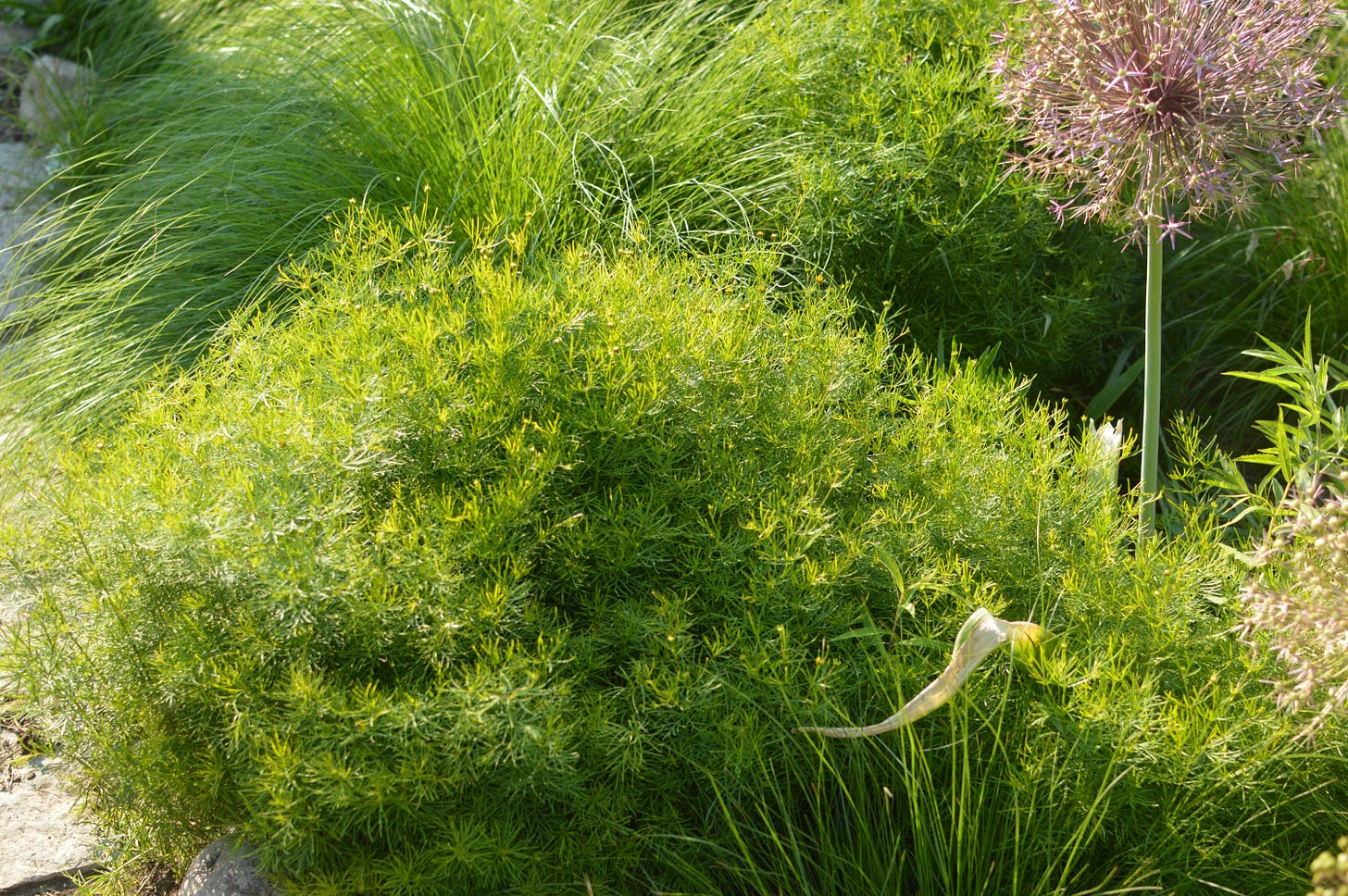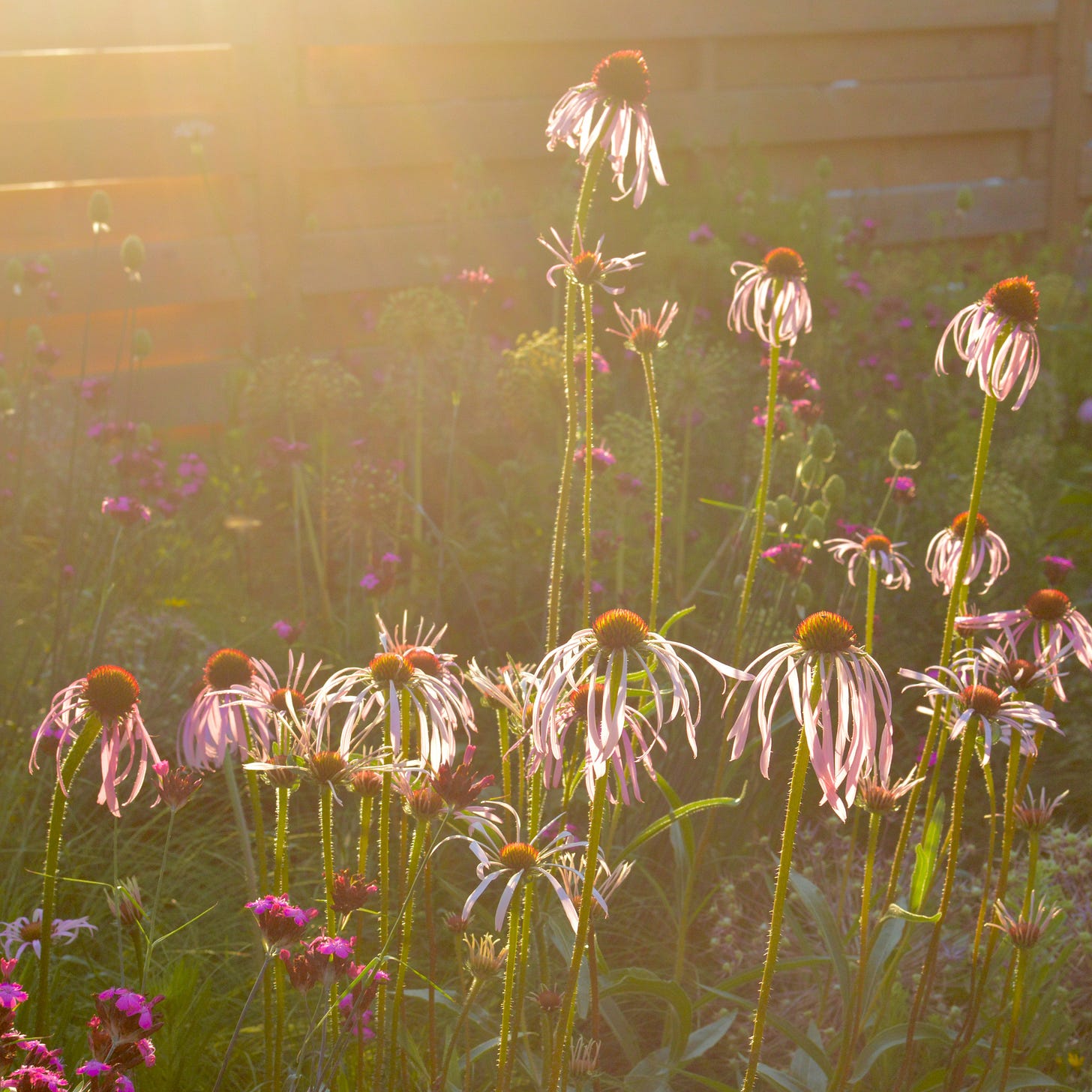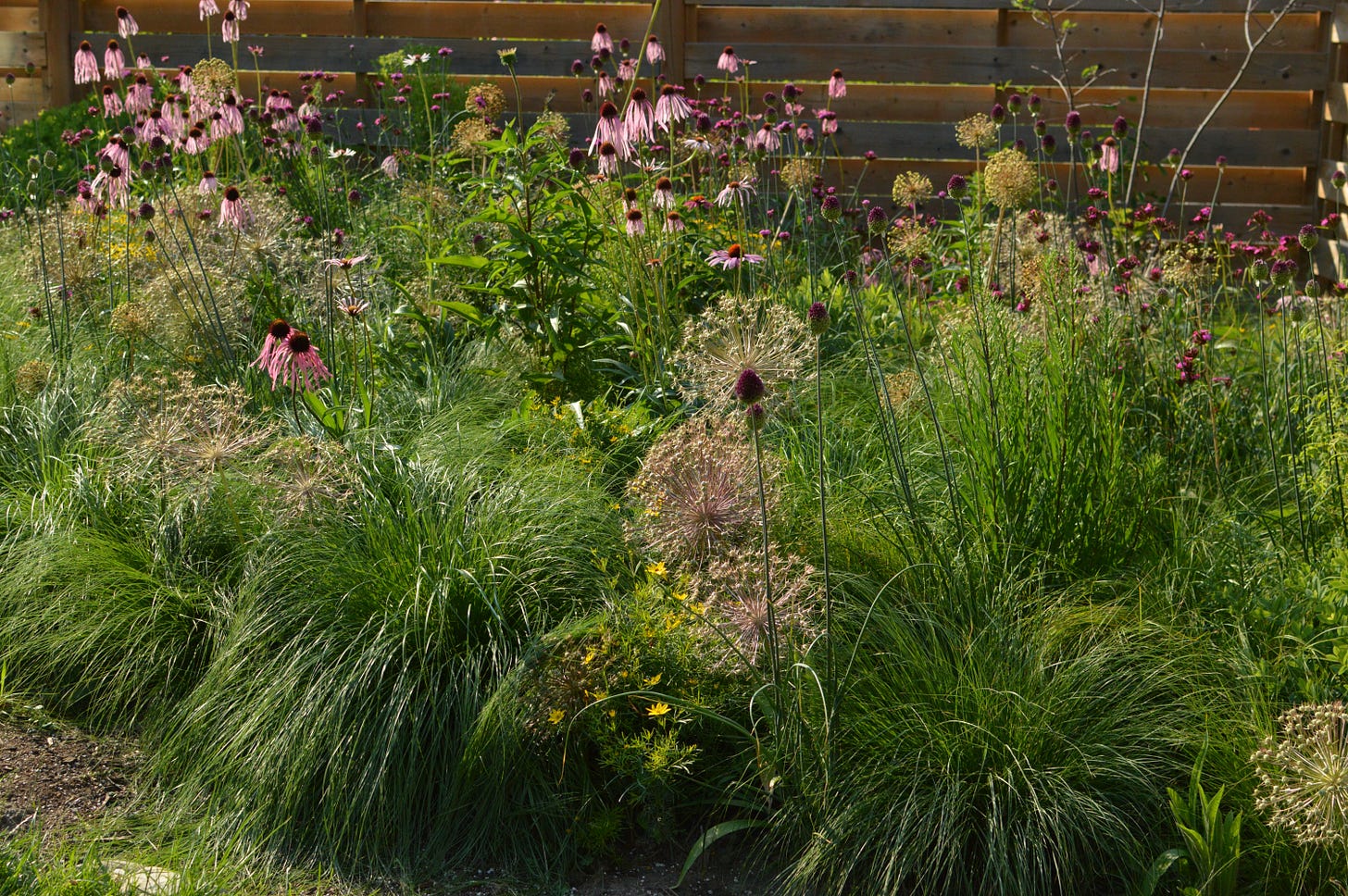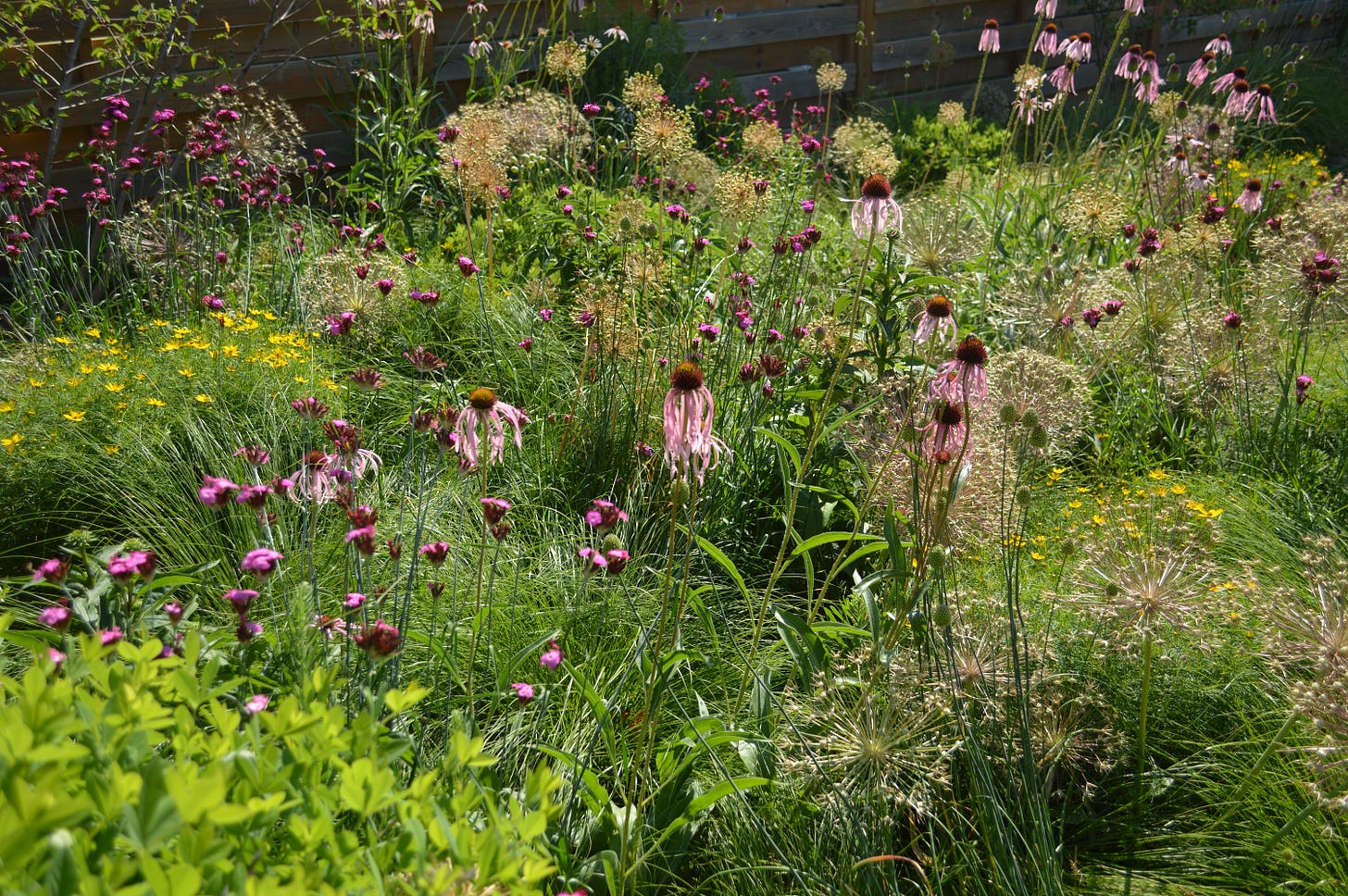Is there a grass vibe?
Plus: the frustrations of gardening, airy textures and the ultimate flower for grass
Garden 2024: a lament
Michael Pollan claims the “garden is an unhappy place for the perfectionist.” I tend to think most places are unhappy ones for perfectionists–that’s the problem with unrealistically high standards–but I know what he means. Gardening is uniquely frustrating. Henk Gerritsen puts it this way:
Gardening is the most elusive of all the fine arts. The art of gardening uses living material, which has its own laws and prerogatives and which won’t allow itself to be manipulated by the artist without a struggle.
I’ve struggled plenty this year in the garden.
I lost some plants over the winter. My Dianthus carthusianorum didn’t self-seed as expected. The Penstemon hirsutus I planted last year were blooming wonderfully for a week before being mowed to the ground by hungry bunnies (they must have been hungry because the internet tells me Penstemon is not palatable to bunnies!). My beloved Echinacea pallida (more on that in a minute) flowered weakly or, in some cases, not at all, despite healthy-looking foliage.
Then, our one-year-old puppy got the zoomies and thundered through our thickening June garden, snapping a number Coreopsis tripteris stems clean in half.
It was the culmination of a series of disasters. Up to then, I had been coping stoically with the mysterious “laws and prerogatives” of my plants. But the sheer senselessness of puppy energy was too much for me. I shouted, slammed doors, and sank, despondent, onto the couch. I refused even to inspect the damage outside (which was not as bad as initially suspected).
Some of the frustration of gardening stems from the nonlinear nature of gardening progress. Each year you set about to solve last year’s problems–a few weeks when nothing blooms, a plant that is getting too aggressive, the need for a height at the back of the border, etc. But with the new season comes a set of dilemmas. I had been so concerned with boosting my Fall display but then, suddenly, my late Spring garden collapsed. So perhaps you take three steps forward but also two steps backward, and while it’s still progress, it’s never quite the triumphant victory you imagined.
Textures in the grass garden
If there’s been a silver lining to a less floriferous Spring and early Summer garden, it’s that I’ve had a chance to appreciate the textures of my plants. And I realized that I’m a sucker for one particular type of texture–delicate, fine, soft, airy, feathery.
Here are some examples from my garden:
Prairie dropseed
Adiantum pedatum:
Coreopsis verticillata:
My preference for these textures is why I struggle with the house plant trend. I can’t get behind those broad, chunky, variegated leaves that are so highly prized.
But while I’m crazy for the airy aesthetic, there’s a risk of the garden feeling a bit too light and ephemeral, as though it might lift off and float away with the next gust of wind. I have to remind myself that some contrast in leaf size is important. The coarser leaves of Echinacea purpurea, Eupatorium maculata and Cercis canadiensis provide some much-needed weight, but I should probably add more like this.
A decadent flower made for grass
Though it’s having a rough year in my garden, I still need to talk about my favourite flower, the one I couldn’t imagine gardening without: pale purple coneflower or Echinacea pallida.
The flower is not for everyone. My wife’s not keen on it for example. The first year we had Pallida in our garden, she asked me, “are they supposed to look like that?”
“Like what?” I responded, bristling.
“Like they’re dying.”
I didn’t appreciate the comment at the time but, in fairness to my wife, they do sort of look like they’re dying. The petals are thin and pale and they fall straight back from the cone. They flutter in the slightest breeze, looking liable to drop at any moment. And yet, for me, there is something elegant in their droopy, sickly form.
I have two reference points for these flowers. First, I imagine them as the sort of flower that Aubrey Beardsley or Oscar Wilde or any of the Decadent artists of the late 19th century would have been crazy for. These artists had a thing for sinuous, languid forms. Here’s Beardsley’s The Climax:
And then I think of a child’s art project–something crudely pasted together, oddly proportioned and all awkward angles, but charming and cheerful in its way.
Anyway, Echinacea Pallida is a perfect flower for grass. It carries most of its leaves low down, on the bottom third of the plant where they’re often obscured by surrounding plants. As a result, the focus is entirely on the spidery flowers, which emerge from the fine grassy foliage on long twisting stems. It’s stark and striking.
Look how they dance above prairie dropseed (what a combo!):
Emily Dickson and the vibe of grass
I’ve been thinking further about the appeal of grass (here’s my first go at this theme). For me–and I think I’m not unique here–there’s a specific grass vibe, one I associated with laziness and long summer days.
A patch of grass is a wonderful setting for idleness. As kids, we lie on the grass and watch the clouds drift by. We calibrate ourselves to the slow rhythms of summer.
Grass itself can appear lazy. It lacks the ambition of trees, growing to modest heights each year. And unlike trees and shrubs, grass doesn’t harden its limbs against the elements, but stays lax and loose. Its bendiness is a source of strength: in a storm, grass flaps about wildly but its stems never snap.
Emily Dickinson has a brilliant little poem on this theme, a true classic of the grass canon:
The Grass
The grass so little has to do, —
A sphere of simple green,
With only butterflies to brood,
And bees to entertain,
And stir all day to pretty tunes
The breezes fetch along,
And hold the sunshine in its lap
And bow to everything;
And thread the dews all night, like pearls,
And make itself so fine, —
A duchess were too common
For such a noticing.
And even when it dies, to pass
In odors so divine,
As lowly spices gone to sleep,
Or amulets of pine.
And then to dwell in sovereign barns,
And dream the days away, —
The grass so little has to do,
I wish I were the hay!
Though Dickinson begins with a declaration of grass’s idleness, she goes on to ascribe all sorts of actions to it: it “entertains” “bees”, “broods” “butterflies,” “hold[s]” “the sunshine in its lap,” “stir[s] all day to pretty tunes/The breezes fetch along,” etc. These actions all suggest a particular attitude: a playful engagement with meadow companions, an attunement to the surrounding world. What little the grass does is social in nature, nurturing others rather than building itself up.
The association between grass and idleness is not always seen positively, however. There’s that ugly phrase “put out to pasture,” which means to make someone retire. In this instance, grass is a place of enforced idleness, a kind of banishment—irreversible, final—from the realm of productive labour. You have to be put out to pasture because, presumably, you want to stay and work. Perhaps in a society dominated by the work ethic, grass’s negative connotation is inevitable.
But Dickinson’s poem gives us another message: embrace the idle life, attend closely to the bees, butterflies and passing clouds. Put yourself out to pasture. Be present, be grass.











